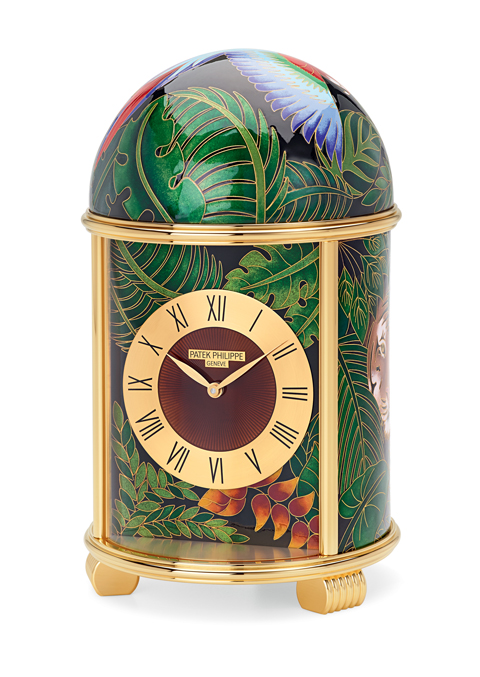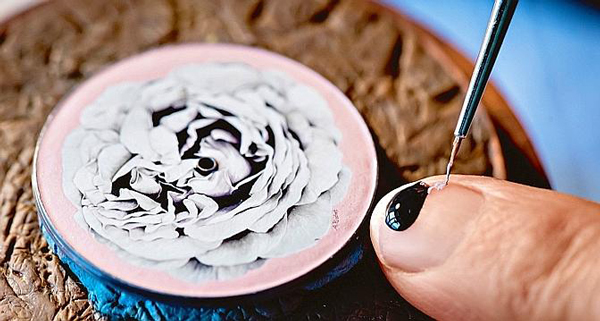In the early days of the mechanical renaissance, enameling had all but died out – like many other hand-worked, often artistic elements of haute horlogerie no longer taught in watchmaking schools. Now, more than twenty-five years into this new silver age of mechanical watchmaking, work being done by hand is emphasized by a good deal of high-end mechanical watch companies as both a return to past values and to underscore the preciousness and nobleness of the high-quality, high-priced products they create. In an age of mass-production, the handmade mechanical watch with its artisan elements also emphasizes one other thing to draw collectors and interested parties: the aspect of this one object being unique. A hand-painted dial will always be unique, for a painter paints the same motif slightly differently each time. Given its extreme level of difficulty and decorative aspect, a traditionally hand-enameled dial is always sought-after.

At the recent launch event for Patek Philippe’s Sky Moon Tourbillon, as a matter of fact, company president Thierry Stern explained how there was a time when the company had up 80 of their dome clocks in stock at one point because enamel had fallen out of favor in the quartz era. “That doesn’t happen to us today,” he explained. “We can’t keep them in stock; we only make ten in one year now, and if we can make that many I am very happy. Those ten are now sold in less than a week.”
The event showcased enamel watches and dome clocks from one year’s worth of production at Patek Philippe’s factory, where the brand now has an in-house enameller. “We were the only brand still ordering pieces from the independent enamellers, even when business was down,” Stern continued. “If we hadn’t they would not have had any work or practice, and one day they would have disappeared. It was our duty to help them.”
Cloisonné
The early enamel pieces of the modern era were generally created by Anita Porchet, who many consider the premier artisan in this field. Donzé Cadrans, which was purchased by Ulysse Nardin in 2011, was also an early proponent. In the last two decades, Porchet – who works as a freelancer – has created beautiful enameled dials for the likes of Ulysse Nardin, Patek Philippe, Van Cleef & Arpels, Roger Dubuis, Vacheron Constantin, Piaget, Jaquet Droz, Hublot and Milus. Many of these dials were created using the difficult cloisonné technique, which involves separating the colored fields with miniscule gold threads smaller in diameter than a hair, practically tracing the outlines of a scene’s figures.

Another element that makes enameling so difficult to master is the fact that the artist must mix his or her powder agents in just the right way so that they fire evenly in the kiln without splattering, which will happen when too much water has been added to the powder and it begins to boil. If the paste is too dry, it will not stay on the surface for which it was intended. Enamel must be fired many times to achieve its incredible richness and depth – which is its main advantage over miniature painting.
High fire, big talent
Dominique Baron, who sadly passed away last year, was the young enameller who created DeLaneau’s in-house enamel workshop. A patient woman who relished delving into the secrets of this craft, she applied her colored powders, which are composed of elements such as silicium and metallic oxides, with a steady hand and then fired them in a kiln at the very high temperature of 800° C, which allowed the powders to melt and flow like liquid. DeLaneau’s enameling powders come from India as they are known for their vibrancy and purity of color and composition.

The truth is that a great enameller must be not only an artist, but also a bit of an alchemist, as each color has special characteristics that demand that the enameller judge in advance what will happen under the extreme conditions of the kiln. Too much heat and the created color mixture becomes worthless; too little, and it will not achieve perfect flow and translucency. Some colors are so difficult that they demand separate firings, while others can only be fired in certain color combinations. As many as fifteen individual layers of enamel are required to create visual depth, and each is fired separately, which increases risk of damage or burning in the kiln. Oftentimes, firing is followed by a polishing stage. Only many years of experience can bring perfect results to this craft and even then, the finesse required is so delicate that pieces are often ruined because of conditions outside of the enameller’s control, such as small differences in the composition of the metal oxides. This makes the perfect pieces all the more valuable.
Once the actual painting is done, a DeLaneau piece is still far from finished. The Geneva technique utilized by the brand’s enamellers requires that a transparent coating called fondant de finition be applied in another ten to fifteen layers, adding brilliance and depth to the painting located underneath it and giving the composition a glass-like finish.
Next week, we will take a look at other styles of enamel.








